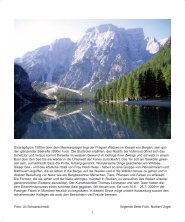Tobique First Nation, NB August 2010 - Schaarschmidt IT
Tobique First Nation, NB August 2010 - Schaarschmidt IT
Tobique First Nation, NB August 2010 - Schaarschmidt IT
Create successful ePaper yourself
Turn your PDF publications into a flip-book with our unique Google optimized e-Paper software.
It is a climbing vine related to the pea family, and it is a distant relative of the soybean.<br />
Similar to other legumes it has nitrogen fixing properties, which is beneficial when grown<br />
with other nitrogen hungry vegetables like corn and squash. The roots also grow in long<br />
strings like the vines that are above ground. Tubers grow along the root strings much<br />
like beads in a necklace. The larger and more nourished the vine, the larger the tubers<br />
will grow. They can be as small as a jellybean or as large as a lemon. These tubers are<br />
where the plant gets its English names of groundnut and Indian Potato. Like potatoes,<br />
they can be peeled and are white with a firm flesh inside. Their flavour is mild like a<br />
potato too. They can be eaten fresh, boiled, baked like the potato, or added to soups<br />
and stews. But they are even better for you than potatoes, having three times the<br />
protein. The tubers also contain estrogenic isoflavones (phytoestrogens) such as<br />
genistein, which has anticancer properties. This is accomplished by preventing the<br />
formation of blood vessels that nourish new tumours.<br />
Now comes the most interesting part. The groundnut of the Wolastoqiyik is unique to<br />
their people and territory. There is no other like it. It produces flowers, but it does not<br />
produce the tiny pods full of seeds after the flowers drop. It cannot reproduce by seed<br />
like its more southern relatives in the New England states. It can only reproduce by the<br />
tubers. Therefore all plants from this variety are clones, and none of the clones can<br />
reproduce by seed either.<br />
In 1973 Dr. Jane Seabrook did a study of this plant for writing a Master's thesis at the<br />
University of New Brunswick (Study of the Genus Apios. 1973. Janet E.A. Seabrook),<br />
and subsequently she published an article in the Canadian Journal of Botany (Seabrook,<br />
Janet E.A. 1976. Studies on the genus Apios. I. Chromosome number and distribution of<br />
Apios americana and A. priceana. Can. J. Bot. V. 54. No. 22). In her own words Dr.<br />
Seabrook writes, "I think we established a good case for the species being out of its<br />
normal geographic range because of transport by Native Peoples. As far as we could<br />
tell, there seemed to be only one clone in Eastern Canada, and all plant material in<br />
Eastern Canada that we sampled were triploid (three rather than the normal two sets of<br />
chromosomes). This would explain why there were no seed pods because triploid<br />
plants are nearly always sterile. Furthermore, triploid plants are common at the northern<br />
and southern ranges of many native plants." The she adds this interesting note, "We<br />
always found Apios americana plants growing near or downstream from either Native<br />
Peoples portage sites or reservations. If you look at Hal Hinds’ Flora of New Brunswick,<br />
it is quite remarkable that the distribution of Apios americana follows waterways or<br />
coastal areas."<br />
So this nutritious plant was primarily spread throughout Wolastoq land by the ancestors<br />
who carried them on hunting trips and on other journeys, stopping at the end of a<br />
portage to rest and munch on a few of these little round tubers. I have wandered along<br />
the historic locations of Wolastoqiyik encampments along the river and in the islands<br />
and found these plants. In these same locations are almost always the sunchokes,<br />
beach plums, and butternut trees, all common foods gathered and stored by the<br />
Wolastoqiyik to help them through the hard times of the season when food was most<br />
scarce. How many of today's younger generation walk right past these nutritious and<br />
free foods that helped their ancestors survive?





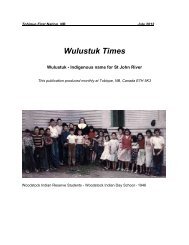
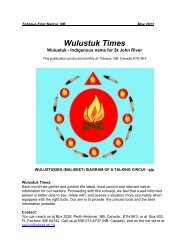
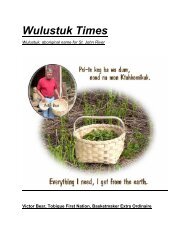
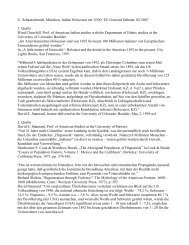

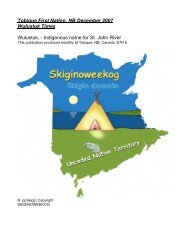

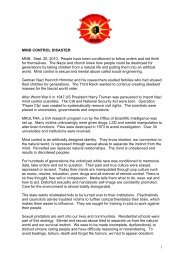

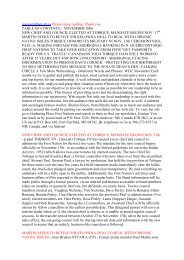
![WE HOLD THE ROCK [ALCATRAZ], SAID ... - Schaarschmidt IT](https://img.yumpu.com/22715400/1/184x260/we-hold-the-rock-alcatraz-said-schaarschmidt-it.jpg?quality=85)
